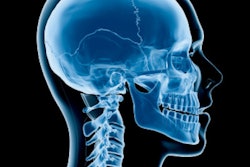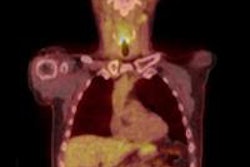CHICAGO - Using F-18 FDG-PET/CT scans to evaluate the response of patients who received chemoradiotherapy for head and neck cancer can prevent unnecessary dissections for some, researchers from the U.K. and the U.S. said at an RSNA 2011 scientific session.
Although each of the session presenters cautioned that more analysis is needed, wider use of this examination might prevent neck dissections that would ultimately prove to be unnecessary once pathological evaluations are completed.
Dr. Manil Subesinghe, a radiation oncologist at Leeds Teaching Hospitals NHS Trust, presented the findings of a study evaluating the use of F-18 FDG-PET/CT to assess delayed response to treatment in stage IV head and neck squamous cell carcinoma patients following radical chemoradiotherapy. The scans were performed 13 to 24 weeks after treatment completion.
The medical records of a total of 30 patients who received treatment at Leeds during a three-year period beginning November 2007 were evaluated. Patients ranged in age from 31 to 75 years, and 60% of the cancers were of oropharyngeal origin.
Almost three-fourths of the patient cohort had negative results and were classified as having a complete response to treatment. The PET/CT scans for 20% of the patients revealed metastatic disease, nodal disease, or signs of the primary tumor. The remaining 7% were equivocal for either tumor or local recurrence.
"Only one patient of the 22 who had a negative PET/CT exam had disease progression," Subesinghe said. "Although this is a small series, we think that negative F-18 FDG-PET/CT scans will be a good predictor of clinical outcome when they are performed ideally between 13 and 17 weeks after treatment."
The researchers have followed the patients a median of 14 months; the group will present updated outcomes at 24 months. Subesinghe and colleagues believe the exams could spare some patients neck dissections that would prove to be unnecessary, he said.
Radiation oncologists at Fox Chase Cancer Center in Philadelphia conducted a similar study and reached a similar opinion. Presenter Dr. Mauricio Gamez said that he and his colleagues believed that the percentage of standardized uptake value (SUV) decrease could determine which patients could avoid neck dissection.
In this study, the exam results of 22 patients with stage III or IV head and neck cancers were analyzed. The patients ranged in age from 41 to 84 years, and they received chemoradiotherapy treatment between May 2001 and June 2008. Squamous cell carcinomas comprised 91% of the total, and of these 64% were oropharyngeal in origin.
The patients were predominantly male (86%) and active smokers (73%). Only 5% did not drink alcohol. These factors were analyzed by the research team, along with T stage, N stage, type of treatment, treatment duration, and PET scan response, Gamez said.
Lower-risk patients were prescribed up to 56 Gy of radiation, and high-risk patients received up to 70 Gy. Nearly 60% of the patients also received cisplatin-based chemotherapy.
The PET/CT examinations were performed slightly later than at Leeds, at a median of 17 weeks. The median SUV prior to treatment for the primary tumor region was 11.71, and for lymph node regions it was 5.45. Following treatment, these values were 2.24 and 1.02, respectively. Half of the patients had a 100% decrease, Gamez said.
Ten patients ultimately had neck dissection, one of whom had regional failure. Three patients had pathological residual disease after neck dissection.
The patients have been followed a median of 18 months, with a range of three to 51 months. The survival rate at three years was 93%, and to date, 60% are alive.
"We believe that patients with good PET scan results can safely avoid neck dissection," Gamez concluded. "We recommend that pathologies be correlated with residual post-treatment SUVs to evaluate locoregional failure in a larger number of patients."




















